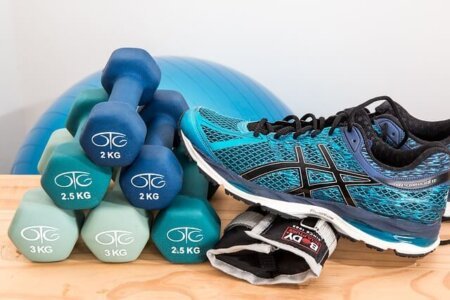Fitness is a journey filled with opportunities for growth, health, and self-improvement, but it’s also a field surrounded by countless myths and misconceptions. These fitness myths, often spread by word of mouth or outdated information, can lead to confusion, ineffective workouts, or even potential harm.
From the idea that lifting weights makes you bulky to the belief that you need to sweat buckets to see results, separating fact from fiction is crucial for anyone looking to achieve their health and fitness goals. In this article, we’ll debunk some of the most common fitness myths, helping you navigate your path to a healthier, stronger you with confidence and clarity.
KNOWING WHAT FITNESS MYTHS ARE AND UNDERSTANDING THE TRUTH BEHIND THEM IS CRUCIAL FOR SEVERAL REASONS:
Maximize Results: Fitness myths can lead to ineffective workouts or practices that waste time and energy. Knowing the facts allows you to focus on evidence-based methods that deliver real results.
Prevent Injury: Misconceptions, like improper form or unrealistic workout expectations, can increase the risk of injuries. Understanding myths helps you adopt safe, sustainable practices.
Save Money: Fitness fads and false claims often drive people to spend money on unnecessary equipment, supplements, or programs. Being informed helps you avoid wasting resources.
Boost Motivation: Believing in myths, such as the idea that progress must come quickly or that fitness is all or nothing, can lead to frustration and burnout. Debunking these myths promotes a healthier, more encouraging mindset.
Promote Long-Term Success: Understanding what works and what doesn’t fosters consistency and smarter decision-making, leading to sustainable fitness habits and goals.
Stay Informed: As science evolves, so does our understanding of fitness. Knowing what’s true versus outdated helps you stay current and make informed choices.
By dispelling myths, you empower yourself to create a fitness plan based on truth and effectiveness, leading to a healthier and more fulfilling lifestyle.
PEOPLE OFTEN FALL VICTIM TO FITNESS MYTHS DUE TO A COMBINATION OF MISINFORMATION, SOCIAL INFLUENCES, AND PERSONAL EXPECTATIONS. HERE ARE THE TOP REASONS WHY:
Lack of Education: Many people are not familiar with the science behind fitness and health, making it easy to accept myths that sound logical or authoritative.
Influence of Social Media: Fitness influencers and unqualified personalities often promote myths, creating widespread misinformation that appears credible due to their large followings.
Desire for Quick Results: Myths promising rapid weight loss, muscle gain, or other dramatic outcomes appeal to people looking for shortcuts, even if the claims are unrealistic.
Outdated Information: Old fitness advice, like “no pain, no gain” or the need for long cardio sessions to lose weight, persists despite being debunked by modern research.
Marketing and Advertisements: Fitness products and services often use myths to market themselves, such as promoting miracle supplements or gadgets that promise easy success.
Peer Influence: Friends, family, or gym peers may unknowingly spread myths they believe, reinforcing misinformation within social circles.
Complexity of Fitness Science: The science of fitness can be complicated, and myths often simplify complex concepts, making them easier to believe and adopt.
Fear of Missing Out (FOMO): When myths are tied to trends or popular workout routines, people may feel compelled to follow them to avoid being left behind.
Understanding why myths persist helps individuals critically evaluate fitness advice and seek out credible, evidence-based information.
THE FITNESS WORLD HAS SEEN MANY MYTHS OVER THE PAST DECADE, FUELED BY TRENDS, SOCIAL MEDIA, AND MISINFORMATION. HERE ARE SOME OF THE MOST PERSISTENT FITNESS MYTHS:
“Lifting weights makes you bulky.”
This myth discourages many, especially women, from strength training, but building bulky muscle requires specific training, diet, and genetics. Strength training is vital for toning, health, and metabolism.
“You can spot-reduce fat.”
Targeting fat loss in specific areas (e.g., belly, thighs) through exercises like crunches is not possible. Fat loss occurs systemically, and genetics play a role in where you lose fat first.
“Cardio is the best way to lose weight.”
While cardio burns calories, strength training is equally, if not more, important for long-term fat loss because it boosts metabolism and helps maintain muscle mass.
“No pain, no gain.”
Pain is not a sign of a good workout; it can indicate overtraining or injury. Progress comes from consistency and pushing yourself appropriately, not from overdoing it.
“You need protein immediately after a workout.”
While post-workout nutrition is essential, the “anabolic window” is longer than once believed. You don’t need to rush to consume protein right after a workout.
“Sweating equals a good workout.”
Sweating is a natural way to regulate body temperature, not a direct indicator of workout intensity or calorie burn.
“Detox teas and cleanses promote weight loss.”
Detox products often cause temporary water loss, not fat loss. The body has its own detox system—your liver and kidneys do the job.
“Rest days are unnecessary.”
Recovery is critical for muscle repair and overall progress. Overtraining without rest can lead to injuries and burnout.
“Machines are safer than free weights.”
While machines can guide movements, free weights often provide a more functional workout and engage stabilizing muscles. Proper form is key for safety with both.
“You have to work out for hours to see results.”
Quality trumps quantity. Short, effective workouts, like HIIT or focused strength sessions, can yield significant benefits without taking hours.
“You should stretch before exercising.”
Static stretching before exercise may reduce performance and increase the risk of injury. Dynamic warm-ups are better for preparing muscles for activity.
“BMI is the best measure of health.”
BMI overlooks muscle mass, bone density, and overall body composition, making it an outdated and incomplete measure of health.
These myths have persisted due to oversimplified science, marketing, and the appeal of quick fixes. Staying informed helps debunk them and supports smarter fitness decisions.
MANY NEW FITNESS MYTHS OFTEN STEM FROM EMERGING FADS OR TRENDS. THESE MYTHS TYPICALLY GAIN TRACTION THROUGH SOCIAL MEDIA, CELEBRITY ENDORSEMENTS, OR CLEVER MARKETING CAMPAIGNS THAT PROMISE QUICK FIXES OR REVOLUTIONARY RESULTS. HERE’S HOW THIS HAPPENS:
Trendy Workouts: New workout styles, like “sweat until you drop” classes or extreme regimens, often bring myths, such as the need to overtrain for success or that one workout is a one-size-fits-all solution.
Quick-Fix Products: Fads like waist trainers, fat-burning supplements, or detox teas often promote myths, claiming to deliver rapid results without effort. These products play on people’s desires for shortcuts.
Misrepresentation of Science: Trends often twist legitimate research to fit a marketable narrative. For instance, the rise of the keto diet brought myths like “carbs are bad for everyone” or “you can’t gain muscle on low carbs.”
Viral Challenges: Social media challenges, such as doing 100 squats a day or extreme ab workouts, can spread myths about how fitness progress works, often focusing on unsustainable routines.
Tech-Driven Fads: Wearable fitness technology and apps sometimes perpetuate myths, like overemphasizing calorie burn as the sole measure of workout success.
Influencer Culture: Influencers with little to no scientific expertise often promote fitness myths to align with their brand or sell a product, giving these ideas a false air of credibility.
While not all trends are harmful, many oversimplify or misrepresent fitness science, leading to misconceptions. It’s essential to evaluate trends critically and rely on evidence-based practices for long-term health and fitness.
HERE ARE SOME ADDITIONAL ASPECTS OF FITNESS MYTHS THAT YOU MAY WANT TO KNOW ALSO:
Cultural and Historical Roots
Many fitness myths have roots in cultural or historical practices. For example, the idea that you must stretch before exercise dates back decades when static stretching was the norm in warm-ups. Over time, science has debunked it, but the myth persists.
Placebo Effect
Believing in a myth can sometimes produce a placebo effect, where people feel better or more successful simply because they expect a certain outcome, even if the method isn’t effective.
Gender-Specific Myths
Some myths disproportionately affect men or women. For example:
Women are often told not to lift heavy weights to avoid becoming “too bulky.”
Men might believe they must consume excessive protein to build muscle, often leading to unnecessary or even harmful practices.
Overcomplication of Fitness
Fitness myths often make health and exercise seem more complicated than they need to be. Myths like needing specific foods, supplements, or routines can discourage beginners who feel overwhelmed.
Perpetuation Through Authority Figures
Sometimes, even well-meaning fitness professionals, coaches, or trainers perpetuate myths because they learned outdated practices or were misinformed themselves.
Psychological Impacts
Fitness myths can lead to guilt, anxiety, or frustration when individuals don’t achieve unrealistic results promised by these misconceptions. For example, believing that progress should always be linear can discourage people when they hit natural plateaus.
Diet Myths and Their Connection to Fitness
Diet myths often intertwine with fitness, such as believing you must eat specific foods to enhance performance or that fasting ruins muscle gains. These misconceptions can disrupt both training and recovery.
Media Amplification
Mainstream media often oversimplifies or sensationalizes fitness science, spreading myths like “sitting is the new smoking” or “muscle turns to fat when you stop exercising,” creating confusion and fear.
Regional Variations in Myths
Different regions or countries may have unique fitness myths influenced by cultural practices, traditional diets, or local fitness trends.
Resistance to Debunking
Even when myths are debunked, people often cling to them due to cognitive biases, like the “appeal to tradition” or the “bandwagon effect.” Breaking through these mental barriers requires consistent education and clear communication.
Addressing these dimensions can help people better understand why fitness myths persist and how to avoid falling for them.
DEBUNKING A POSSIBLE FITNESS MYTH REQUIRES A COMBINATION OF CRITICAL THINKING, RESEARCH, AND SKEPTICISM. HERE ARE SOME FIRST STEPS TO FOLLOW:
Identify the Claim
Clearly define what the myth is claiming. For example, is it about a specific workout, diet, or result?
Break it down into smaller, testable ideas if necessary.
Check the Source
Determine where the information is coming from: Is it a reputable fitness professional, a social media influencer, or anecdotal evidence?
Trust sources backed by science, such as academic studies, certified trainers, or recognized fitness organizations.
Seek Scientific Evidence
Look for peer-reviewed studies or reputable articles that address the topic.
Use trusted databases like PubMed or fitness sites affiliated with health organizations.
Consult Experts
Reach out to certified personal trainers, sports scientists, or registered dietitians for their input.
Ask if they’ve heard of the claim and their perspective on its validity.
Look for Consensus
If multiple credible sources agree the myth is false (or true), it’s likely to be accurate.
Beware of single studies or outlier opinions that contradict a broader consensus.
Apply Logic and Critical Thinking
Does the claim make sense based on what you know about human physiology? For example, “spot reduction” contradicts basic principles of fat metabolism.
Ask yourself if the claim sounds too good to be true—quick fixes often are.
Experiment Safely
If it’s a fitness technique or routine, try it for yourself within reason and safety guidelines. Sometimes, personal experience can help verify claims.
Pay attention to measurable results and potential side effects.
Compare with Established Principles
Cross-reference the claim with fundamental fitness principles like progressive overload, balanced nutrition, and the importance of recovery.
Claims that stray too far from these basics may warrant skepticism.
Avoid Confirmation Bias
Be open to the possibility that the myth could be true or false.
Seek evidence that challenges your existing beliefs to ensure an unbiased evaluation.
Share Findings Responsibly
Once you’ve verified the truth, share the information with others in a balanced way, avoiding sensationalism or exaggeration.
By following these steps, you can assess fitness myths critically and confidently navigate the sea of misinformation.
IT’S USUALLY BETTER TO INVESTIGATE AND VERIFY FITNESS MYTHS THROUGH RESEARCH AND EXPERT ADVICE RATHER THAN SIMPLY TRYING THEM OUT TO SEE IF THEY WORK. HERE’S WHY:
Safety First
Some fitness myths could lead to injury or harm, such as overtraining, improper technique, or using unsafe products.
Experimenting without proper knowledge might have long-term negative effects on your health or well-being.
Saves Time and Effort
Myths often promise quick results but rarely deliver. Testing them can waste valuable time and energy that could be spent on proven methods.
Cost Efficiency
Many myths involve purchasing expensive products or services (e.g., detox teas, “miracle” equipment) that may not work. Research can save you from unnecessary expenses.
Avoids False Expectations
Trying a myth may lead to frustration if the promised results don’t materialize. Research helps set realistic expectations.
Science Provides Better Answers
Evidence-based practices are more reliable than trial-and-error. Science has already debunked many myths, providing clear guidance on what works and what doesn’t.
Not All Results Are Immediate
Fitness progress, like muscle gain or fat loss, often takes weeks or months to show. Testing a myth could lead to misleading conclusions, as short-term changes may not reflect actual effectiveness.
Personal Bias
People’s experiences are influenced by placebo effects, genetics, and lifestyle factors. Research removes these variables, providing an objective perspective on the myth.
Builds Knowledge
Investigating myths helps you understand fitness principles better, empowering you to make informed decisions in the future.
When Testing Might Be Appropriate
If a myth involves a harmless workout or dietary tweak, testing it could be an option, but only after confirming that it is safe and aligns with basic fitness principles. Always prioritize evidence-based practices and safety over trial-and-error approaches.
FITNESS MYTHS OFTEN ARISE FROM A VARIETY OF SOURCES, MANY OF WHICH BLEND MISINFORMATION, OVERSIMPLIFICATION, AND MARKETING. HERE ARE THE TOP SOURCES OF FITNESS MYTHS:
Social Media
Why It’s a Problem: Influencers and unverified accounts often share oversimplified or sensationalized advice to gain followers and engagement.
Example: Claims like “waist trainers give you abs” or “drink this tea to burn fat” spread rapidly.
Tip: Verify advice with reputable fitness professionals or scientific research.
Celebrity Endorsements
Why It’s a Problem: Celebrities often promote fitness fads or products without evidence, focusing more on marketability than effectiveness.
Example: Endorsing detox teas, special diets, or “miracle” exercises with no real scientific basis.
Tip: Recognize that endorsements are often driven by financial incentives, not expertise.
Trendy Fitness Programs
Why It’s a Problem: Some programs exaggerate results or introduce gimmicks to differentiate themselves in a crowded market.
Example: Programs claiming you can “target belly fat” with specific exercises.
Tip: Look for programs designed by certified trainers with evidence-based approaches.
Marketing and Advertising
Why It’s a Problem: Companies use fitness myths to sell products or services, often preying on insecurities.
Example: Ads suggesting that you need supplements to build muscle or lose weight effectively.
Tip: Be cautious of claims that sound too good to be true and research the product thoroughly.
Outdated Advice
Why It’s a Problem: Older fitness advice sometimes lingers, even when science has disproven it.
Example: The idea that you must stretch statically before exercising, which has been replaced by dynamic warm-ups.
Tip: Stay updated with modern fitness research and practices.
Gym Culture and Word of Mouth
Why It’s a Problem: Well-meaning gym-goers or trainers might pass on incorrect advice based on personal beliefs rather than science.
Example: “No pain, no gain” or “you must lift heavy weights to see results.”
Tip: Question advice and verify it with certified experts or research.
Pseudoscientific Websites and Articles
Why It’s a Problem: Some fitness content is written without credible sources or research backing.
Example: Claims like “eating after 6 PM causes weight gain.”
Tip: Rely on well-sourced articles or scientific journals for accurate information.
Fitness Fads and Challenges
Why It’s a Problem: Viral challenges (e.g., 30-day abs challenge) often oversimplify complex fitness principles, leading to myths about results.
Example: Believing that doing 100 sit-ups daily will give you a six-pack.
Tip: Understand that lasting results require balanced programs, not quick-fix challenges.
Supplement Industry
Why It’s a Problem: Aggressive marketing by supplement companies often exaggerates the benefits of products.
Example: “Take this pill and lose 10 pounds in a week.”
Tip: Check the science behind supplements and focus on proven nutrients like protein, vitamins, and minerals.
Misinterpreted Scientific Studies
Why It’s a Problem: Media or fitness gurus sometimes misinterpret studies to create catchy headlines or oversimplify findings.
Example: “Carbs make you fat” oversimplifies the relationship between diet and weight gain.
Tip: Read the full study or rely on trusted experts to interpret findings correctly.
Fitness myths thrive where there’s a combination of incomplete knowledge, emotional appeal, and persuasive messaging. By identifying these sources, you can critically evaluate claims and avoid falling for misleading information.
NOW THAT YOU’VE BUILT A STRONG UNDERSTANDING OF FITNESS MYTHS—WHY THEY EXIST, HOW TO DEBUNK THEM, AND THEIR SOURCES—YOU CAN TAKE YOUR KNOWLEDGE TO THE NEXT LEVEL. HERE ARE SOME PRACTICAL STEPS FOR WHERE TO GO FROM HERE:
Apply What You’ve Learned
Evaluate Your Fitness Routine: Reflect on your own practices. Are there myths you might have followed unknowingly? Adjust based on evidence-based methods.
Share With Others: Help friends, family, or your fitness community spot and debunk myths, promoting healthier habits.
Deepen Your Knowledge
Study the Science: Explore reputable fitness resources, such as peer-reviewed journals, books by experts, or courses on exercise physiology and nutrition.
Learn From Professionals: Follow certified trainers, dietitians, or sports scientists who consistently provide accurate, research-backed advice.
Stay Updated
Follow Industry News: Fitness trends evolve, and new myths will emerge. Subscribe to trusted fitness blogs, podcasts, or publications.
Question Trends: When a new fad arises, practice critical thinking and apply your myth-debunking skills to assess its validity.
Promote Awareness
Create Content: Write blogs, make social media posts, or start a YouTube channel addressing common myths and providing evidence-based tips.
Host Discussions: If you’re part of a gym or fitness community, organize workshops or informal talks on busting myths and building smarter routines.
Incorporate Variety Into Your Fitness Journey
Experiment Responsibly: Try new exercises, diets, or techniques that align with scientific principles. Document what works for you, keeping track of realistic results.
Adapt for Longevity: Build a sustainable fitness lifestyle that combines proper nutrition, effective exercise, and adequate rest.
Develop a Balanced Perspective
Avoid Extremes: While myths often oversimplify, so does rejecting all trends outright. Find a balance between skepticism and openness.
Focus on Fundamentals: Revisit key principles like consistency, gradual progression, and holistic health (including mental and emotional well-being).
Consider Formal Training
Certifications: If fitness is a passion, consider earning a personal trainer or nutrition coach certification. This can deepen your expertise and open opportunities to guide others.
Specialization: Explore niches like sports performance, rehabilitation, or holistic wellness.
Join or Build Communities
Collaborate: Engage with like-minded individuals in forums, social media groups, or local meetups to share insights and grow together.
Be a Mentor: Offer to mentor beginners in their fitness journey, teaching them to avoid myths and embrace evidence-based practices.
Set New Goals
Fitness Goals: Whether it’s running a marathon, lifting a personal best, or improving flexibility, use your knowledge to set and achieve realistic goals.
Educational Goals: Commit to learning more about fitness-related topics like biomechanics, functional training, or dietetics.
Evaluate Progress Periodically
Reflect on how your understanding of fitness myths has changed your approach to health and wellness. Are you seeing better results? Do you feel more confident in making decisions?
By staying curious and proactive, you can transform your understanding of fitness myths into a lifelong journey of growth, learning, and helping others.
TO DIVE DEEPER INTO DEBUNKING FITNESS MYTHS, THERE ARE SEVERAL TRUSTED SOURCES YOU CAN EXPLORE FOR RELIABLE INFORMATION. THESE SOURCES WILL HELP YOU NOT ONLY BETTER UNDERSTAND THE MYTHS BUT ALSO EQUIP YOU WITH THE KNOWLEDGE TO ASSESS AND CHALLENGE THEM CRITICALLY.
1. Reputable Websites and Resources
- Examine.com: This site is dedicated to evidence-based information on supplements and nutrition, providing detailed analysis of popular claims.
- PubMed: A database of peer-reviewed scientific studies where you can search for studies related to fitness, nutrition, and exercise science.
- National Academy of Sports Medicine (NASM): Offers a wide range of resources on exercise science and personal training certifications, focusing on research-backed methods.
- American Council on Exercise (ACE): Provides educational resources, articles, and research to help debunk myths and promote proper fitness principles.
2. Fitness & Health Books
- “The Science and Fine Art of Food and Nutrition” by Arnold Ehret: Focuses on food, digestion, and the myths around diet and health.
- “Fitness Made Simple: The Power to Change Your Body, The Power to Change Your Life” by John Romaniello: Explains fitness concepts and common myths.
- “Strength Training Anatomy” by Frederic Delavier: Gives an in-depth, anatomical approach to strength training with facts that can debunk many myths.
- “Bigger Leaner Stronger” by Michael Matthews: Offers scientifically backed fitness and nutrition advice that challenges common myths in the fitness industry.
3. Academic Journals & Fitness Research
- Journal of Strength and Conditioning Research: Offers in-depth articles on exercise science and debunks many popular fitness myths.
- Journal of Strength and Conditioning Research
- Sports Medicine: An authoritative journal offering studies on the science of exercise, training, and health that often tackles myths and misconceptions.
4. Popular Fitness YouTube Channels
- Jeff Nippard: A science-based fitness YouTuber who delves into common myths and research-backed fitness practices.
- Athlean-X: A channel by physical therapist Jeff Cavaliere, focusing on evidence-based workout techniques and busting myths about fitness.
- The Proof: A YouTube channel focused on scientific insights into fitness myths and how to achieve real results.
5. Fitness Podcasts
- The Mind Pump Podcast: Covers the latest in fitness and debunks many myths surrounding workout routines, nutrition, and supplementation.
- The Strength Running Podcast: Offers evidence-based training advice for runners and fitness enthusiasts, often addressing myths and misconceptions.
- Strength Running Podcast
6. Social Media Accounts of Experts
- Dr. Mike Israetel (@drmikeisratel): A fitness expert and professor who regularly debunks myths related to bodybuilding, fat loss, and exercise science.
- Alan Aragon (@alanaragon): A nutrition expert who shares evidence-based insights on fitness and health, addressing myths in the process.
- Precision Nutrition (@precisionnutrition): Offers educational content based on nutrition science, busting myths about dieting and weight loss.
7. Fitness and Nutrition Courses
- Coursera: Offers free or affordable courses from universities and institutions on fitness, nutrition, and health. Search for courses on exercise science to gain a deeper understanding of fitness myths.
- NASM Certifications: Becoming certified in fitness can give you an in-depth understanding of exercise science and the ability to distinguish between myths and facts.
- NASM Certifications
8. Forums and Communities
- r/Fitness (Reddit): A community of fitness enthusiasts where you can ask questions, share experiences, and find evidence-based information to debunk myths.
- Bodybuilding.com Forums: Another space where users discuss fitness myths, trends, and science-based practices.
- Bodybuilding.com Forums
9. Fact-Checking and Myth-Busting Websites
- Snopes: Although typically known for debunking myths in broader fields, Snopes occasionally tackles popular fitness and health claims.
- Science-Based Medicine: Focuses on debunking pseudoscientific health and fitness claims, offering evidence-backed information.
These resources will provide you with well-rounded, evidence-based information on fitness myths and help you stay on top of the latest research. By using these tools, you can build a deeper understanding of the science behind fitness practices and keep yourself—and others—safe from misinformation.Top of Form
If you liked this Share It!
Unleash your BOHOtude – visit BOHOtude Apparel for a selection of free-spirited apparel.


















